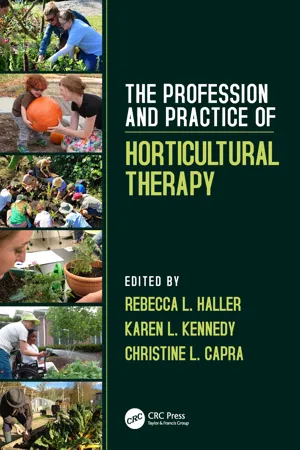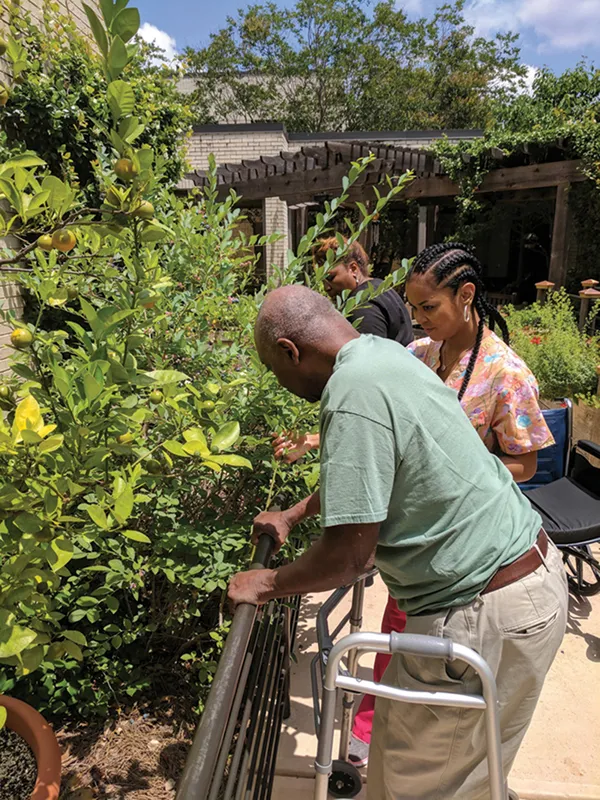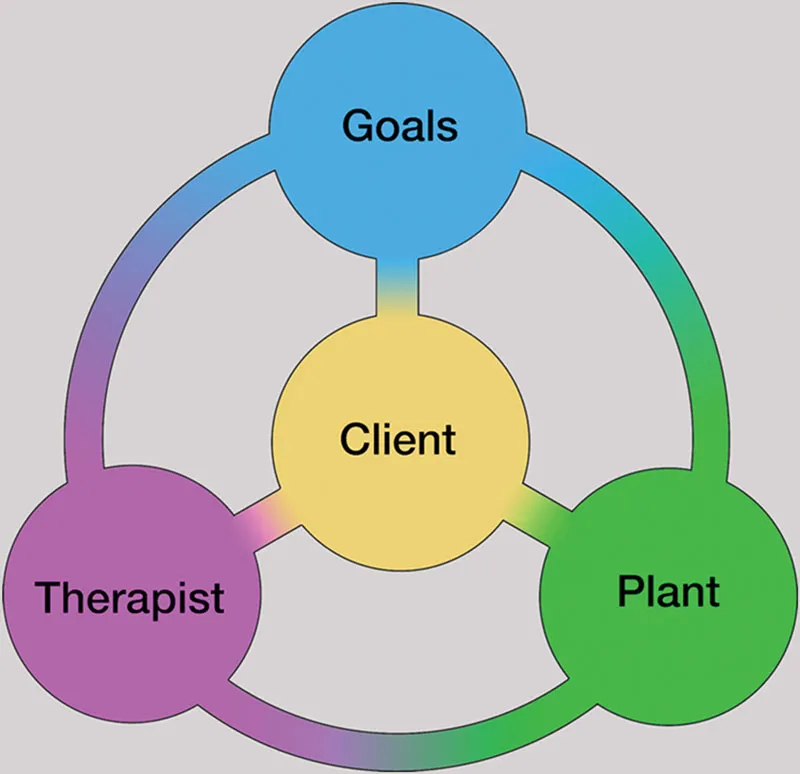![]()
section one
Overview of horticultural therapy practice
This section provides foundational information and perspectives on the profession of horticultural therapy, including background, history, and evolution, as well as assets and challenges of the field to inform the reader of key events, definitions, and perspectives that influence the current status of the profession globally. Comparisons to related fields are intended to provide a framework for distinguishing the unique aspects of horticultural therapy as well as the connections to other initiatives and practices. A “Therapeutic Use of Horticulture Spectrum” is introduced to further explore the range of interventions using plants. Likewise, the approach and methods described in later chapters may be based on the principles involved in therapeutic relationships discussed in Chapter three. Section one is intended to be the basis for interpreting subsequent sections of the book.
![]()
chapter one
Introduction to the profession of horticultural therapy
Christine L. Capra, Rebecca L. Haller, and Karen L. Kennedy
Contents
What is horticultural therapy?
Distinguishing horticultural therapy from similar practices
Training and education in horticultural therapy
History
University degrees
Certificates
Internships
Organizations
American Horticultural Therapy Association
Horticultural therapy around the world
Benefits
The skilled horticultural therapist
Skills and knowledge
Professional credentials
Personal traits
Summary
References
Horticultural therapy can literally change the world. In its wide-ranging past, present, and future applications, it has the potential to be one of the most effective catalysts for positive human growth and well-being. At its core, horticultural therapy works with the needs and assets of individuals in order to enhance overall wellness. That may take many different forms and be accomplished in ways that are as diverse as are people and types of horticulture. The scope of practice is broadened by the imagination and resourcefulness of practitioners and by those who support it. Many human issues of an individual, regional, or global nature may be addressed in part by this developing approach to therapy. For example, connection to nature through goal-directed horticultural therapy may help to alleviate stress and stress-related illness brought on by increasing global urbanization. Food production that is incorporated into programming in any model of horticultural therapy—vocational, therapeutic, or wellness—may have an impact on nutrition, food security, and skills, which transfer to daily living outside a health care facility. A person or family who is displaced or homeless may find a place of “rootedness” in a garden, which brings hope and solace. A person who struggles with addiction may find a healthier “high” in the act of cultivation. Gardening with the guidance of a skilled professional therapist offers real work opportunities and can address coping skills, offer acceptable outlets for anger management, and teach nurturance and self-care. These and other outcomes are not only possible but to be expected through the use of horticultural therapy.
“As horticultural therapists we are ‘agents of change.’ We mediate the process through which people recover, adjust, or cope …” Richard H. Mattson (1992). Horticultural therapists bring unique and multidisciplinary skills to the process of change, emphasize the strengths in those served, and offer an intimate connection with nature through engagement in gardening. The therapy may result in small, profound, and/or even life-altering results for program participants (clients). Whatever the outcomes, the process offers many gifts to the therapist as well as the client. In addition to the satisfaction of seeing incremental improvements in a client’s quality of life, therapists also reap the benefits of working in a plant-rich environment and enjoy self-nurturing through the cultivation of plants. They regularly witness the wonders of nature as well as human capacity and resilience (Figure 1.1).
Throughout history the connection between plants and people has permeated life. This chapter will discuss the profession of horticultural therapy—a unique modality—that bridges the people–plant connection. In addition to an overview of the profession, a brief history of the development of horticultural therapy will be discussed, as well as characteristics, program models, general benefits, and educational options in the field.
Assertions of the beneficial worth of horticulture trace back to ancient Egypt and continue through to modern times, and understanding that gardens, in and of themselves, have the capacity to bring about solace is not hard to appreciate. Yet incorporating intimate and active engagement in plant cultivation adds another dimension to the beneficial relationship. Bringing this engagement with plants to a level of therapy is one that requires knowledge and skill in plant cultivation as well as human service. Horticultural therapy is the modality that seeks to bring these together—utilizing the innate pull of our connection to the active participation in gardening in a formal and therapeutic setting where goals and objectives are utilized to meet the needs of the individual. It is this unique connection that sets horticultural therapy apart.
Figure 1.1 Experiencing the garden. Experiencing the garden. (Courtesy of Kirk Hines.)
What is horticultural therapy?
“Goals of the programs differ, but the basic premise behind horticultural therapy is that working with and around plants brings about positive psychological and physical changes that improve the quality of life for the individual” (Relf 1992). Since the formation of the horticultural therapy profession, a full gamut of definitions and models have been used, ranging from strict descriptions of its use in health care fields to those that are broadly expressed, and they may even include any beneficial horticultural experience (Dorn and Relf 1995). As a young profession, definitions have evolved and continue to do so. Some historical and contemporary descriptions are chronicled here in order to provide perspective on the evolution of the field and an understanding of the genesis of current descriptions.
In Therapy Through Horticulture, published in 1960, Donald Watson and Alice Burlingame explained the purpose of horticultural therapy as “the improvement of physical and mental health,” adding that it may also prevent and aid in the recovery from illness as well as provide vocational rehabilitation. Unlike more contemporary definitions, the horticultural therapy they portrayed was sponsored by an organization such as a garden club or auxiliary, staffed by volunteers who loved gardening, and was not to be considered a “distinct therapy.” Rather it was considered an activity to support other forms of treatment (Watson and Burlingame 1960). This book illustrates therapeutic activity prior to future presentations of the field as an emerging profession. In Watson and Burlingame’s descriptions, those who conducted the gardening activities did not require professional training or skills in therapy; rather, they acted as volunteers who brought gardening activity to patients and others. Understanding this lack of training and the activity roots of the profession sheds light on the ongoing challenge to maintain a professional image of horticultural therapy practice and employment. (Chapter 4 details this and other issues faced in the continued development of horticultural therapy as a profession.)
Coinciding with the emergence of the field in the 1970s was the first textbook in horticultural therapy written by Damon Olszowy. It explained the principles that made horticultural therapy a “distinct discipline” and provided guidelines and methods for the establishment of programs (Olszowy 1978). Olszowy described modern therapy as related to “total personality needs,” “concerned first with the individual and second with the disability itself,” with the aim to improve both mental and physical well-being. Rehabilitation similarly had the objective to help a person improve mentally, physically, socially, and vocationally, in order to lead a healthy and full life. Horticultural therapy was described as addressing therapy and rehabilitation in a manner that emphasized planning to meet therapeutic outcomes, along with specific activities to address patient needs. The role of the horticultural therapist was to help the client form effective relationships to support positive individual change. This description by Olszowy outlined a new way of viewing horticultural therapy, which has persisted in its basic form to present day.
In the decades following Olszowy’s book, numerous authors around the world have explored definitions and models for horticultural therapy, which generally include at least three elements: a trained professional, a client in some form of treatment with defined goals, and the cultivation of plants. While terminology may vary somewhat, these elements have been emphasized by numerous authors (Hefley 1973; Mattson 1982; Haller 2006; Haller and Capra 2018). Additionally, Diane Relf presented a model that illustrated the therapeutic benefits of horticultural therapy and has provided a foundation for programs, research, and documentation of the value of horticultural therapy to the present day (Relf 1981). It categorized the benefits to program participants as emotional or psychological, social, intellectual or cognitive, and physical. Richard Mattson described a series of models to depict the interactions between the client, plant and horticultural therapist, and the various types of bonding that occur between each of these elements in actual practice. The bonding is influenced by the status of the client at any particular time, the setting, and plants, as well as the actions of the therapist. He also modeled the client at various levels of engagement in the horticulture activity and addressed group situations in which the therapist adopts directive and participatory approaches (Mattson 1982).
Another definition that combines the elements involved in the process along with the outcomes to be achieved was offered by Rebecca Haller in 2006: “Horticultural therapy is a professionally conducted client-centered treatment modality that utilizes horticulture activities to meet specific therapeutic or rehabilitative goals of its participants. The focus is to maximize social, cognitive, physical and/or psychological functioning, and/or to enhance general health and wellness” (Haller and Kramer 2006; Haller and Capra 2018).
A model presented to illustrate this definition depicts the client, goals, therapist, and plant as the elements involved in the process of horticultural therapy (Figure 1.2). Note that the client is central—all the other elements exist to bring goal-directed positive change to the individual participant (client), with the guidance of a skilled professional (therapist) who utilizes hands-on horticulture (plants) with the client.
Matthew Wichrowski created a model of horticultural therapy practice, which is presented in Chapter 7, depicting “the interaction of beneficial features of the environment, therapeutic use of self, and utilization of gardening and horticultural activities as prescribed exercise, which meet the needs of the participant” (see Figure 7.1).
Definitions and descriptions of horticultural therapy vary around the world, yet they generally include the elements just described. Some emphasize the clinical nature of the work, while others are more inclusive. Exhibit 1.1 describes a somewhat broader definition in German-speaking countries of “garden therapy.” It shows the perspective of the Internationale Gesellschaft GartenTherapie (IGGT), which reflects their actions in defining the scope of their work and the rationale behind their philosophies. Also described is a practice example from the author reinforcing the holistic nature and range of benefits achievable in nature-based practices. While similar in concept to the definition used above, this one also takes into account nature’s passive influence on a person.
Figure 1.2 Horticultural therapy elements and process. Model by Rebecca L. Haller, Illustration by Moss Cremer. (With kind permission from Taylor & Francis Group: Horticultural Therapy Methods: Connecting People and Plants in Health Care, Human Services, and Therapeutic Programs, 2nd ed., 2017, 7, Haller, R.L. and Capra, C.L.)
EXHIBIT 1.1
Perspectives: The Idea of Garden Therapy in German-Speaking Countries
For some time, the Internationale Gesellschaft GartenTherapie (IGGT) has worked to create a formal definition of garden therapy. That sounds so easy, but it isn’t. The situation in German-speaking countries, with different health systems utilizing many ther...


